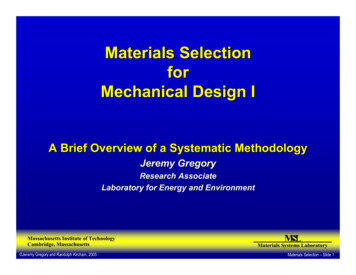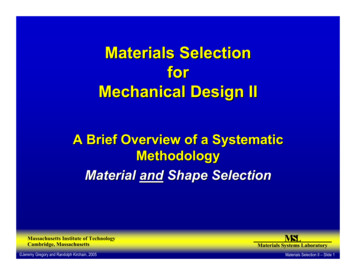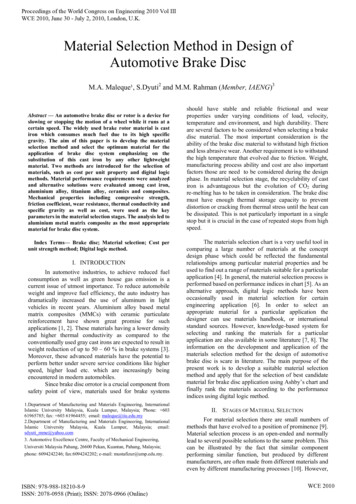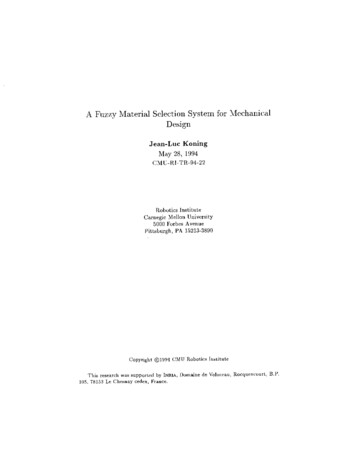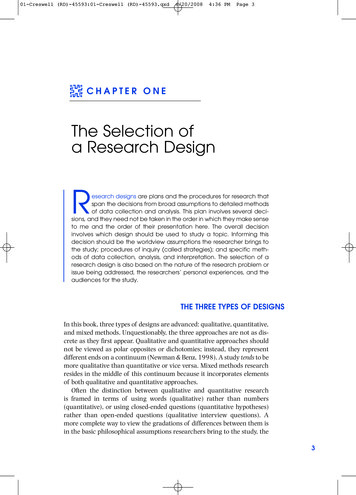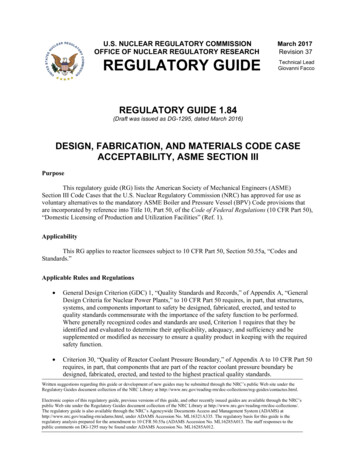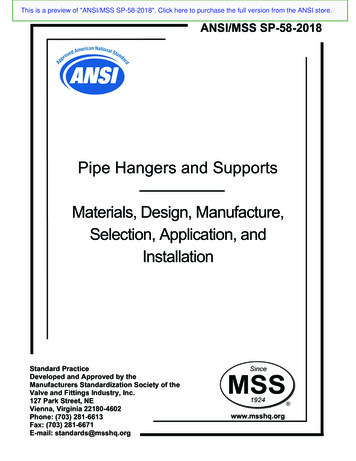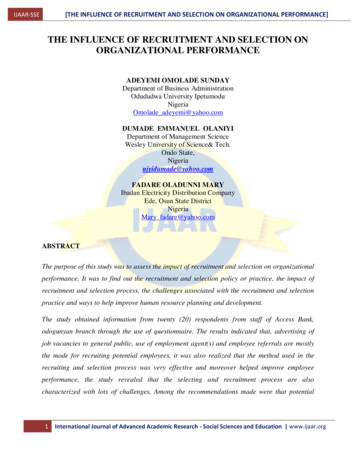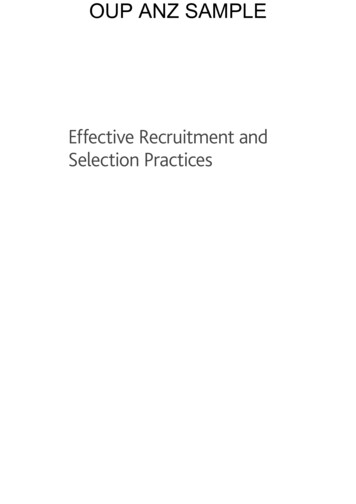
Transcription
Materials Selection and DesignFor selection, one must establish a link between materials andfunction, with shape and process playing also a possiblyimportant role (now ignored.)MaterialsAREAS OF DESIGN CONCERNAttributes: physical,Function- support a load, contain amechanical, thermal,pressure, transmit heat, etc.electrical, economic,What does component do?environmental.Objective- make thing cheaply, light weight,increase safety, etc., or combinations of these.What is to be maximized or minimized?Design & Selection: Materials IndicesfunctionMaterial index is a combination of materials properties that characterizes thePerformance of a material in a given application.shapePerformance of a structural element may be specified by thefunctional requirements, the geometry, and the material’s properties.processConstraints- make thing cheaply, light weight,increase safety, etc., or combinations of these.What is non-negotiable conditions to be met?What is negotiable but desired conditions?P f1(F) f 2(G) f3(M)MatSE 280: Introduction to Engineering Materials D.D. Johnson 2004Function, Objective, and ConstraintIndexTie, minimum weight, stiffnessE/ρBeam, minimum weight, stiffnessE1/2/ρBeam, minimum weight, strengthσ2/3 /ρBeam, minimum cost, stiffnessE 1/2/CmρBeam, minimum cost, strengthσ2/3 /CmρColumn, minimum cost, buckling loadE 1/2/CmρSpring, minimum weight for given energy storageσYS 2/EρThermal insulation, minimum cost, heat flux1/(α Cmρ) α thermal condMatSE 280: Introduction to Engineering Materialsκ Cpρ D.D. Johnson 2004P[ (Functional needs, F); (Geometric, G); (Material Property, M)]Consider only the simplest cases where these factors form a separable equation.Examples of Materials IndicesElectromagnet, maximum field, temperature risePERFORMANCE:For OPTIMUM design, we need to MAXIMIZE or MINIMIZE the functional P.Following “Materials Selection in Mechanical Design”, M. AshbyMatSE 280: Introduction to Engineering MaterialsStructural elements perform physical functions (carry load or heat, store energy,.),and so they must satisfy certain functional requirements specified by the design,such as specified tensile load, max. heat flux, spring restoring force, etc. D.D. Johnson 2004Design & Selection: Materials IndicesPERFORMANCE: (using separable form)P f1(F) f 2(G) f3(M)When separable, the optimum subset of materials can be identified without solving the complete design problem, knowing details of F and G.Cm cost/massThere is then enormous simplification and performance can beoptimized by focusing on f 3(M), which is the materials indexS safety factor should always be included!κ elec. condMatSE 280: Introduction to Engineering Materials D.D. Johnson 20041
Price and Availability of MaterialsRelative Cost (in ) of Materials Current Prices on the web (a) : TRENDS-Short term: fluctuations due to supply/demand.-Long term: prices increase as deposits are depleted. Materials require energy to process them:AlPETCusteelglasspaper237 (17) (b)103 (13) (c)97 (20) (b)20(d)13(e)9(f)Recycling indicated in green. Reference material :-Rolled A36 carbon steel.- Cost of energy used inprocessing materials ( /GJ) (g)- Energy to producematerials (GJ/ton)elect resistancepropanenatural gasoilaabcdefg251198 Relative cost fluctuatesless than actual cost ov/EE/industry ebriefs/cb5.htmlMatSE 280: Introduction to Engineering Materials D.D. Johnson 2004Materials Selection Examples in MechanicalDesign with Separable Performance FactorPERFORMANCE: functional needs , geometry, and materials indexP f1(F) f 2(G) f3(M) --- optimize the material index f3(M).Example 1: Material Index for a Light, Strong, Tie-RodExample 2: Material Index for a Light, Stiff Beam in TensionExample 3: Material Index for a Light, Stiff Beam in DeflectionExample 4: Torsionally stressed shaft (Callister Chapter 6)Example 5: Material Index for a Cheap, Stiff Support ColumnExample 6: Selecting a Slender but strong Table LegExample 7: Elastic Recovery of SpringsExample 8: Safe Pressure Vessel(some from M.F. Ashby)Based on data in AppendixC, Callister, 6e.MatSE 280: Introduction to Engineering Materials D.D. Johnson 2004Example 1: Material Index for a Light, Strong, Tie-RodA Tie-rod is common mechanical component.Functional needs: F, L, σf Tie-rod must carry tensile force, F. NO failure. Stress must be less than σf. (f YS, UTS) L is usually fixed by design, can vary Area A. While strong, need to be lightweight, or low mass.A x-areaF- Mass of rod:-Strength relation:F σf ASm ρLA Eliminate the "free" design parameter, A: m (FS)(L)ρσ fminimize for small mOr Maximize Materials Index:For light, strong, tie-rod MatSE 280: Introduction to Engineering Materials D.D. Johnson 2004 /kg( /kg)ref materialMatSE 280: Introduction to Engineering MaterialsM σfρ D.D. Johnson 2004 2
Maximize M σf /ρExample 1’: square rod (it’s all the same!)Consider log σf vs log ρFor fixed M: log M log σf – log ρ constant C Carry F without failing; fixed initial length L.-Strength relation:σfFS - Mass of bar:M ρLc2c2M000 1M What are units of M σf /ρ ? For fixed M, look atlog σf (1/1) log ρ C Eliminate the "free" design parameter, c: 00 1M (FLS)Mρσf For fixed M, you look for linesof slope 1. Along each line materials havethe same M values! But NOT thesame materials properties (σf orρ ) e.g. some less dense (lighter).minimize for small Mspecified by application0 1 Maximize the Materials Performance Index:σf(strong, light tension members) Mindex ρMatSE 280: Introduction to Engineering MaterialsMatSE 280: Introduction to Engineering Materials D.D. Johnson 2004 D.D. Johnson 2004 Example 3: Material Index for a Light, Stiff Beam in DeflectionExample 2: Material Index for a Light, Stiff Beam in TensionF Bar must not lengthen by more than δunder force F; must have initial length L.- Stiffness relation:Fδ ELc2(σ Eε)- Mass of bar:bLδ deflection Bar with initial length L must not deflectby more than δ under force F.m ρLc 2- Stiffness relation:- Mass of bar: F C1EI C1E b 4 C1E A 2 m b2 Lρ ALρδ L3L3 12 L3 12 Eliminate the "free" design parameter, c:m FL2 ρδ Especified by applicationminimize for small m Maximize the Materials Index:(stiff, light tension members)M EρBending is common mode of loading,e.g., golf clubs, wing spars, floor joists.bspecified by application Eliminate the "free" design parameter, A: 1/2 Maximizem 12S (L3) ρ1/2 C L E 1 minimize for small mM Light, Stiff BeamIf only beam height can change (not A), then M (E 1/3 /ρ) (Car door)If only beam width can change (not A), then M (E/ρ) E1/2ρI b 3w MatSE 280: Introduction to Engineering Materials D.D. Johnson 2004MatSE 280: Introduction to Engineering Materials D.D. Johnson 2004 3
Performance of Square Beam vs. Fixed Height or WidthExample 4: Torsionally stressed shaft (Callister Chpt. 6) shaft must carry moment, M t, with length L.Mass plus Twisting Moment, M t: τ 2M t/πR3Light, Stiff Plate E/ρ- Strength relation:τfLight, Stiff Beam E 1/2/ρSLight, Stiff Panel E 1/3 /ρ 2M tπR 3- Mass of bar:m ρπR2 L Eliminate the "free" design parameter, R: 2/3ρm 2 π SM t Lτ 2f / 3(specified by application)minimize for small M Maximize the Material’s Index:(strong, light torsion members) M MatSE 280: Introduction to Engineering Materials D.D. Johnson 2004MatSE 280: Introduction to Engineering Materialsτ 2f / 3ρ D.D. Johnson 2004 Ashby Plot: Strength vs Density (on log scale)M 30 has 1/3 the mass ofM 10 (mass 1/M ρ).2 /3M τρ log τ 3/2 log ρ 3/2 logMStrength, σ (MPa)f10 4Ceramics10 3PMCs100Increasing Mfor strongtorsion membersCermetsSteels grainMetal102alloysodPolymers10wo2grain 3/ 11pe ope3010Increasing Mfor strongtension0.1members0.13* All materials that lie on these lines will perform equally for strength-per-mass basis.However, each line has a different Materials M index, or overall Performance P index.MatSE 280: Introduction to Engineering MaterialsData Overview:Strong & Light Tension/Torsion Members D.D. Johnson 2004slo sl110 30Density, ρ (Mg/m3)MatSE 280: Introduction to Engineering MaterialsAdapted from Fig. 6.22,Callister 6e . (Fig. 6.22adapted from M.F. Ashby,Materials Selection inMechanical Design ,Butterworth-HeinemannLtd., 1992.) D.D. Johnson 20044
Other Material Indices: Cost factorStrength vs DensityConsidering massMaximize:M τ2/3 /ρ Additional constraints maybe added, such as strengthhaving minimum value, e.g.,σf 300 GPa.CRFP are best!Considering(Cost/mass)*mass Seach area is then limitedto the area in plot above alllines (if maximizing).M τ2/3/Cmρ22x10–3Maximize:M τ2/3 /Cmρ13x10–311x10–39x10–31x10–34340 Steel is best!MatSE 280: Introduction to Engineering Materials D.D. Johnson 2004Details: Strong, Light Torsion Members Maximize the Performance Index: P Other factors:/3τ2fρ--require σf 300MPa.--Rule out ceramics and glasses: K Ic too small. Numerical Data:materialCFRE (v f 0.65)GFRE (v f 0.65)Al alloy (2024-T6)Ti alloy (Ti-6Al-4V)4340 steel (oilquench & temper)ρ (Mg/m 3) τf (MPa)1.511402.010602.83004.45257.8780P (MPa) 2/3 m3 /Mg)7352161511 D.D. Johnson 2004Details: Strong, Low-Cost Torsion Members Minimize Cost: Cost Index m /M (since m 1/M) Numerical Data:materialM (MPa) 2/3 m3 /Mg)CFRE (vf 0.65)73GFRE (vf 0.65)52Al alloy (2024-T6)16Ti alloy (Ti-6Al-4V)154340 steel (oil11quench & temper) 8040151105( /M)x100112769374846Data from Table 6.7, Callister 6e . Lowest cost: 4340 steel (oil quench & temper)Data from Table 6.6, Callister 6e . Lightest: Carbon fiber reinf. epoxy(CFRE) member.MatSE 280: Introduction to Engineering MaterialsMatSE 280: Introduction to Engineering Materials D.D. Johnson 2004 Need to consider machining, joining costs also.MatSE 280: Introduction to Engineering Materials D.D. Johnson 20045
Example 5: Material Index for a Cheap, Stiff Support ColumnPerformance of Stiff but Cost Effective Beam(From Ashby “Matierals Selection in Mechanical Design”)Radius, rBuckledeflectiondA slender column of fixed intial length L usesless material than a fat one; but must not beso slender than it buckles under load F.L- No buckling relation:2F Fcrit Nπ 2 EIWith cost considered,now polymers andmetals area useful!- Cost objective:C mCm ALρCmLLoad less than Euler Load.N given by end constraint on column.Cm is the cost/kg of(usually processed)material. Eliminate the "free" design parameter, A:1/2 C 4 nπ specified by application 1/ 2 1/2F L3 C m ρ Maximize E 2 1/2 L E Cheap, Stiff Beam C mρ minimize for small mMatSE 280: Introduction to Engineering MaterialsMatSE 280: Introduction to Engineering Materials D.D. Johnson 2004Example 6: Selecting a Slender but strong Table Leg D.D. Johnson 2004Example 5: (cont)(Note this uses previous example from Ashby.)Luigi Tavolina, furniture designer, conceives of a lightweight table of simplicity,with a flat toughened glass top on slender, unbraced, cylindrical legs.For attractiveness, legs must be solid (to be thin) and light as possible (to maketable easy to move). Legs must support table top and load without buckling. 1/ 2 ρ EMaterial indices: M1 and M 2 EM1 6 (GPa)1/2 /(Mg/m 3)M2 E 100 GPa What material would you recommend to Luigi?- Critical Elastic Load: - Mass of leg:F π2EIL2 π3ER 44L2m ρπR2 LE1/2/ρ guideline (slope of 2) Eliminate the "free" design parameter, R: m 4P π1/ 2 Maximize L2 ρ1/ 2 E 1/ 2 M E1 ρ For slenderness, get R for Critical Load Eq.:1/4 4P 1/2 1 1/4M2 E L r crit3 E π Wood is good choice. So is composite CFRP (higher E). Ceramic meets stated designgoals, but are brittle2 indices to meetMatSE 280: Introduction to Engineering Materials D.D. Johnson 2004MatSE 280: Introduction to Engineering Materials D.D. Johnson 20046
Example 7: Elastic Recovery of SpringsExample 8: Safe Pressure VesselRecall from Hooke’s Law and Resilience, U el σ2/2E.We wish to maximize this, but the spring willl be damage if σ σys . U el σys 2/2E(Torsion bars and lead spring are less efficient than axial springs because some ofthe material is not fully loaded, for instance, the neutral axis it is not loaded at all!)Deflection,dF/2el2F/2 Can show that U (σys /E)/18Addition constraint can be added.F If in-service, a spring under goes deflection of d under force F, then σys2/Ehas to be high enough to avoid permanent set (a high resilience!).Uses info from leak-before-fail example.σ pR/t Design requirementsRpt2atFunction: contain pressure, pObjective: maximum safetyConstraints: (a) must yield before break(b) must leak before break(c) t small: reduces mass and cost Choose t so that at working pressure, p, the stress is less than σys . Check (by x-ray, ultrasonics, etc.) that no cracks greater than 2a c are present;KIcthen the stress required to active crack propagation is σ Y πa c For this reason spring materials are heavily SS-strengthening and work-hardening(e.g, cold-rolled single-phase brass or bronze), SS plus precipitation strengthening(spring steel). Safety (should have safety factor, S) achieved for stress less than this, but greatersafety obtained requiring no cracks proposgate even if σ σys (stably deform). Annealing any spring material removes work-hardening, or cause precipitation tocoarsen, reducing YS and making materials useless as a spring! This condition (σ σys ) yields πac 1 K Ic Y 2 σ ys MatSE 280: Introduction to Engineering MaterialsMatSE 280: Introduction to Engineering Materials D.D. Johnson 2004M1 K
Materials Selection Examples in Mechanical Design with Separable Performance Factor Example 1: Material Index for a Light, Strong, Tie-Rod Example 2: Material Index for a Light, Stiff Beam in Tension Example 3: Material Index for a Light, Stiff Beam in Deflection Example 4: Torsionally stressed shaft (Callister Chapter 6)
